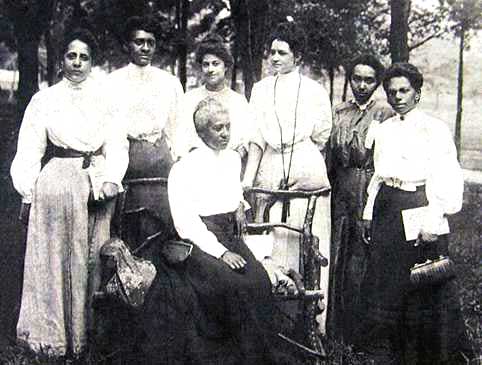|
Harpers Ferry, West Virginia In 2006, Harpers Ferry National Historical Park will commemorate the 100th Anniversary of the gathering of the Niagara Movement, the first major civil rights organization of the 20th century. Founded in 1905 by Dr. W.E.B. DuBois this group was the forerunner to the National Association for the Advancement of Colored People (NAACP). Determined to take their rightful place in society, members demanded equal enforcement of the law for all races and active political involvement at all levels of society. The group’s 1906 meeting, the first on American soil, was held on the campus of Storer College, now part of Harpers Ferry National Historical Park. This three day gathering was later described by W.E.B. DuBois as “one of the greatest meetings that American Negroes ever held.” |
 |
Left:
Women at the 1906 Niagara Movement Conference at Harpers Ferry: Mrs. Gertrude
Wright Morgan (seated) and (left to right) Mrs. O.M. Waller, Mrs. H.F.M.
Murray, Mrs. Mollie Lewis Kelan, Mrs. Ida D. Bailey, Miss Sadie Shorter,
and Mrs. Charlotte Hershaw.
|
What Attracted the Niagara Movement to Harpers Ferry in 1906?
- The area’s natural beauty and history was attractive.
- Storer College provided the facilities for a professional meeting.
- John Brown’s 1859 raid to end slavery converted the town into holy ground.
“A
more suitable place for the Second Annual Meeting of the Niagara Movement
than Harpers Ferry would have been hard to find.”
—Max Barber
Why was the 1906 Niagara Movement meeting at Harpers Ferry important?
- It was their first public meeting.
- It was their first meeting in the United States.
- Women became full-fledged, voting members of the organization.
"...instead
of meeting in secret, we met openly...and had in significance
if not in numbers one of the greatest meetings that American Negroes
ever held. ...and we talked some of the plainest English that
had been given voice to by black men in America."
if not in numbers one of the greatest meetings that American Negroes
ever held. ...and we talked some of the plainest English that
had been given voice to by black men in America."
—W.E.B. Du Bois
Source: Harpers Ferry National Historical Park. National Park Service, U.S. Department of the Interior. Author: David T. Gilbert
